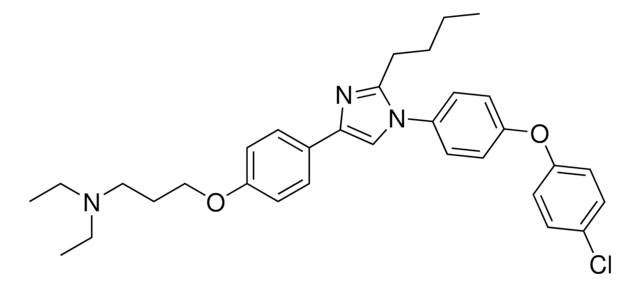E8780
Epiregulin from mouse
recombinant, expressed in E. coli, lyophilized powder, suitable for cell culture
Sinónimos:
EREG
About This Item
Productos recomendados
recombinante
expressed in E. coli
Análisis
≥97% (SDS-PAGE)
formulario
lyophilized powder
mol peso
predicted mol wt ~5.5 kDa
técnicas
cell culture | mammalian: suitable
impurezas
endotoxin, tested
Nº de acceso UniProt
temp. de almacenamiento
−20°C
Información sobre el gen
mouse ... Ereg(13874)
Acciones bioquímicas o fisiológicas
Forma física
Nota de preparación
Epiregulin is a member of EGF (epidermal growth factor) family. All members of the EGF family are synthesized as transmembrane precursors and converted to soluble forms by proteolytic cleavage. Epiregulin was originally purified from the mouse fibroblast-derived tumor cell line NIH3T3/T7. Mouse epiregulin cDNA encodes a transmembrane precursorof 162 amino acids with a mature soluble form consisting of residues 56-101. Epiregulin acts like other EGF family members by binding to and activating the tyrosine kinase ErbB family receptors (ErbB1-ErbB4). Epiregulin has a broad specificity, but this ligand seems to preferentially activate heterodimeric receptor complexes. Epiregulin inhibits the growth of several epithelial tumor cells and stimulates the growth of fibroblasts and other types of cells. Its expression is upregulated in a number of carcinoma cell lines. Epiregulin is also an autocrine growth factor in human epidermal keratinocytes, and involved in the early stages of pregnancy, regulating the attachment of the blastocyst to the uterine epithelium during the implantation process.
Nota de análisis
Código de clase de almacenamiento
11 - Combustible Solids
Clase de riesgo para el agua (WGK)
WGK 3
Punto de inflamabilidad (°F)
Not applicable
Punto de inflamabilidad (°C)
Not applicable
Equipo de protección personal
Eyeshields, Gloves, type N95 (US)
Certificados de análisis (COA)
Busque Certificados de análisis (COA) introduciendo el número de lote del producto. Los números de lote se encuentran en la etiqueta del producto después de las palabras «Lot» o «Batch»
¿Ya tiene este producto?
Encuentre la documentación para los productos que ha comprado recientemente en la Biblioteca de documentos.
Nuestro equipo de científicos tiene experiencia en todas las áreas de investigación: Ciencias de la vida, Ciencia de los materiales, Síntesis química, Cromatografía, Analítica y muchas otras.
Póngase en contacto con el Servicio técnico





